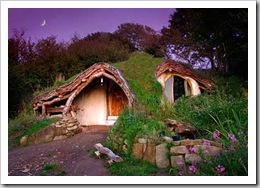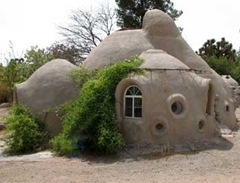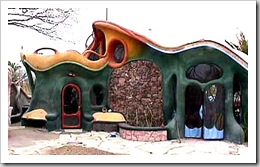Houses gassing off. Carpets, insulation, paint and more. So tight and filled with chemicals they're sick houses. Literally! The building materials are bad for us. Real bad. Have been for years now. Since the '50s we've had Horrible Harmful Housing.
I remember back in the late '70s when I was a young thing living in Pennsylvania. Me and my best beau (that's us in the photo, weren't we cute!) would stop for a look see at houses from time to time. Was fun... we loved it. Once we pulled into a mobile home lot and took a tour. It was hot that day. The sun was frying eggs. Walked in one home. Looked around a bit. It was really nice inside. Could imaging living there. The longer we spent ooing and awing the more our eyes burned and watered. When we both started coughing we beat it out of there fast. Talked about it as we drove away. Said to each other, "We're protected for sure. Thank you God." Came to the conclusion it musta' been the formaldehyde. That was the buzz word back then. The stuff in the insulation that gassed off and made folks sick. They were ripping it out of all the schools.But it's still used in some building materials. Read an article at ABC News dated July 9, 2008, "Makers of Katrina Trailers Grilled by Congress." The mobiles that were bought as temporary housing for hurricane Katrina victims were filled with it. Made some folks sick. Huh. Scratching my head. They were ripping it out in the early 80s why is it still used? In our modern society can't we come up with affordable housing that is people and earth friendly???
Well that got me curious about green housing. Sustainable, affordable, earth friendly? I like words and always find it interesting to look at dictionary definitions. Here is what I found in the Oxford American Dictionary and dictionary.reference online.
The definition of the word sustain: to support; to keep alive; to endure without giving away. To keep in existence; maintain. To supply with necessities or nourishment; provide for. To support the spirits, vitality, or resolution of; encourage. Definition of sustainable: capable of being sustained or maintained. Capable of being continued with minimal long-term effect on the environment. How interesting.
So what does sustainable mean with regard to housing? Here are definitions of sustainable housing I found online:
Sustainable Housing: Affordable and comfortable. Climate appropriate design which minimizes or eliminates the need for artificial heating and cooling. Design and construction which maintain sites natural resources. Collect and efficiently manage water resources. Management of own waste on site including greywater and black water. Produce and efficiently manage electrical power. Provide food resources from a permaculture garden. The house becomes part of the local ecosystem. Use of building materials which are recycled or made from renewable resources.
I enjoy housing designs which are unique and creative. So I did I a search. Found lots of stuff on natural or recycled building materials. Lots from companies building passive solar and other things. I was looking for something more then your average home... something fun, unique, affordable, beautiful, sustainable, earth and people friendly. Here are a few of the inexpensive homes I liked a lot....
A low impact woodland home - beautiful, natural living
 Located in Wales, UK. Built with maximum environmental regard by 2 people and passersby. 4 months start to finish: 1,000-1,500 man hours. Cost: about £3,000 (£60 per sq. ft., not including labor). Part of Lammas ecovillage project a carbon neutral, low impact development.
Located in Wales, UK. Built with maximum environmental regard by 2 people and passersby. 4 months start to finish: 1,000-1,500 man hours. Cost: about £3,000 (£60 per sq. ft., not including labor). Part of Lammas ecovillage project a carbon neutral, low impact development.
Features: Dug into hillside for low visual impact and shelter. Stone/mud at site used for retaining walls, foundations etc. Framed with oak from local woodlands. Reciprocal roof rafters. Straw bales in floor, walls and roof. Plastic sheet and mud/turf roof. Reclaimed wood floors and fittings. Reclaimed windows, burner, plumbing, wiring, etc. Lime plaster walls. Breathable and low energy to manufacture. Heat is wood burning stove - renewable and locally plentiful. Flue through thick stone/plaster. Retains heat. Slowly releases for even warmth. Fridge cooled by underground air through foundation. Skylight in roof. Solar panels for lighting, music and computing. Water gravity system from nearby spring. Composting toilet. Rainwater from roof collects in pond for garden, etc.
Building workshops available. Learn how to build a low impact woodland home.
Thanks to Pipa's Porch for directing me to this wonderful home.
Eco Dome Earth Dwelling - a small gnome-like home
Located in California, USA. House built by students to learn about Superadobe coil construction. Very small, 400 square foot, very low cost. Easily built by 3-5 people. Part of the Cal-Earth educational and research program.
Features: Built from local earth-filled Superadobe coils (soil-cement or lime-stabilized earth) and barbed wire. On site soil utilized, coil bags low cost. Covered with adobe. Tree free. Main dome and four niches, very low cost. Can be repeated and joined together to form larger homes and courtyard houses. Very thick walls have significant thermal mass, which reduces heating and cooling costs. It also provides sound insulation, structural integrity, fire and pest protection. Designed with the sun, shade and wind in mind for passive cooling and heating. Wind-scoop can be combined with a rated furnace unit. Solar energy and radiant heating may be incorporated. Water collection and reclamation can be incorporated. It is estimated that a four-bedroom, 2,000 square foot house would cost $75,000 ($37.50/sq. ft.) to build, including labor, materials and utilities.
Building workshops available. Learn how to build with Superadobe coils online or apprentice at Cal-Earth.
Sculpted concrete homes - Live in Art
 Located in Mexico. Beautiful, imaginative custom, free flowing, sculptured concrete homes built by Flying Concrete. House shown is 700 square foot with various out buildings. Has been a design-as-you-go, evolutionary, spontaneous project. Built by 2 people.
Located in Mexico. Beautiful, imaginative custom, free flowing, sculptured concrete homes built by Flying Concrete. House shown is 700 square foot with various out buildings. Has been a design-as-you-go, evolutionary, spontaneous project. Built by 2 people.
Features: Roofs built with lightweight aggregate. Walls are lightweight concrete or local rock. Vaulted roofs – 400 year guarantee. Solar green house and other interior solar spaces. Passive solar heat and good insulation. Water recovery systems. Detached composting toilet. Low cost units as low as $25 per sq. ft. (2005). Roof represents 10-15% of cost.
Building workshops available. Learn how to build a sculptured concrete home.
Whoo Hoo!!! There are lots of great healthy, natural, beautiful and affordable alternative building techniques that I can learn and do myself. This is so great I can't wait to get started. Now if I only had a plot of land...
There are a lot more green and sustainable building methods, I've only mentioned a couple. Here are some links to additional stuff:
Green Home Building is a website which talks about sustainable architecture and natural building.
Natural Building Network is an association which promotes natural building principles, materials and practitioners worldwide.
Green Builders Directory a listing of various builders who build green and sustainable housing.


2 comments:
I enjoyed reading your post about housing. We are looking to build a dome house very similar to the one from calearth as per you post.
Thankyou for you blog!
Jay
http://sanctuaryproject.wordpress.com
Hi Jay
I'm glad you enjoyed the housing post. Good luck building your new home.
Bonnee
Post a Comment